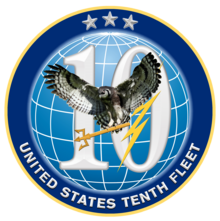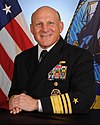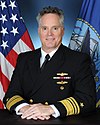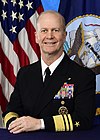
The Sixth Fleet is a numbered fleet of the United States Navy operating as part of United States Naval Forces Europe-Africa. The Sixth Fleet is headquartered at Naval Support Activity Naples, Italy. The officially stated mission of the Sixth Fleet in 2011 is that it "conducts the full range of Maritime Operations and Theater Security Cooperation missions, in concert with coalition, joint, interagency, and other parties, in order to advance security and stability in Europe and Africa." The current commander of the Sixth Fleet is Vice Admiral Thomas E. Ishee.

The Seventh Fleet is a numbered fleet of the United States Navy. It is headquartered at U.S. Fleet Activities Yokosuka, in Yokosuka, Kanagawa Prefecture, Japan. It is part of the United States Pacific Fleet. At present, it is the largest of the forward-deployed U.S. fleets, with 50 to 70 ships, 150 aircraft and 27,000 Sailors and Marines. Its principal responsibilities are to provide joint command in natural disaster or military operations and operational command of all US naval forces in the region.

The Fifth Fleet is a numbered fleet of the United States Navy. It has been responsible for naval forces in the Persian Gulf, Red Sea, Arabian Sea, and parts of the Indian Ocean since 1995 after a 48-year hiatus. It shares a commander and headquarters with U.S. Naval Forces Central Command (NAVCENT) in Bahrain. Fifth Fleet/NAVCENT is a component command of, and reports to, U.S. Central Command (CENTCOM).

Anti-submarine warfare is a branch of underwater warfare that uses surface warships, aircraft, submarines, or other platforms, to find, track, and deter, damage, or destroy enemy submarines. Such operations are typically carried out to protect friendly shipping and coastal facilities from submarine attacks and to overcome blockades.

Combined Task Force 150 (CTF-150) is a multinational coalition naval task force working under the 34-nation coalition of Combined Maritime Forces and is based in Bahrain established to monitor, board, inspect, and stop suspect shipping to pursue the "War on Terror" and in the Horn of Africa region (HOA) includes operations in the North Arabia Sea to support operations in the Indian Ocean. These activities are referred to as Maritime Security Operations (MSO).

United States Naval Forces Central Command (NAVCENT) is the United States Navy element of United States Central Command (USCENTCOM). Its area of responsibility includes the Red Sea, Gulf of Oman, Persian Gulf, and Arabian Sea. It consists of the United States Fifth Fleet and several other subordinate task forces, including Combined Task Force 150, Combined Task Force 158 and others.
The structure of the United States Navy consists of four main bodies: the Office of the Secretary of the Navy, the Office of the Chief of Naval Operations, the operating forces, and the Shore Establishment.
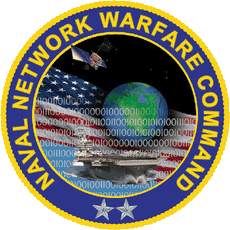
Naval Network Warfare Command (NAVNETWARCOM) is the United States Navy's information operations, intelligence, networks, and space unit. Naval Network Warfare Command's mission is to execute, under Commander TENTH Fleet Operational Control, tactical-level command and control of Navy Networks and to leverage Joint Space Capabilities for Navy and Joint Operations.

Vice Admiral Allan Rockwell McCann, was a United States Navy officer who served in World War I and World War II. His US Navy Serial number was 10829.

The Operational Test and Evaluation Force (OPTEVFOR) is an independent and objective agency within the United States Navy for the operational testing and evaluation (OT&E) of naval aviation, surface warfare, submarine warfare, C4I, cryptologic, and space systems in support Navy and Department of Defense acquisition programs.
Fleet Command is responsible for the command, operations, readiness, training and force generation of all ships, submarines, aircraft squadrons, diving teams, and shore establishments of the Royal Australian Navy. Fleet Command is headquartered at HMAS Kuttabul in Sydney, and is led by the Commander Australian Fleet (COMAUSFLT), also referred to as Fleet Commander Australia (FCAUST), which is a rear admiral (two-star) appointment.

Carrier Strike Group 14 was a U.S. Navy carrier strike group. The group was for some time the only U.S. carrier strike group that did not have an assigned aircraft carrier or carrier air wing. As of December 2010, it directed the cruisers USS Gettysburg (CG-64) and USS Philippine Sea (CG-58). Carrier Strike Group 14 was seemingly last based at Naval Station Mayport. Without a carrier flagship, it did not conduct the typical deployments of other carrier strike groups; instead, its two cruisers made independent voyages.

The U.S. Fleet Cyber Command is an operating force of the United States Navy responsible for the Navy's information network operations, offensive and defensive cyber operations, space operations and signals intelligence. It was created in January 2010 "to deter and defeat aggression and to ensure freedom of action to achieve military objectives in and through cyberspace". U.S. Tenth Fleet was simultaneously reactivated as its force provider. Since it was founded, the command has grown into an operational force composed of more than 16,000 active and reserve sailors and civilians organized into 27 active commands, 40 Cyber Mission Force units, and 27 reserve commands around the world.

VP-67 was a Patrol Squadron of the U.S. Navy Reserve. The squadron was established on 1 November 1970 at NAS Memphis, Tennessee, where it was based for its entire life. It was disestablished on 30 September 1994, after 24 years of service. The squadron's nickname was the Golden Hawks, also unofficially called the Thunder Chickens. Elements of the squadron made 23 major overseas deployments.

The Commander, Task Force 75 , properly named Navy Expeditionary Forces Command Pacific; or simply NEFCPAC, is a US Navy task force of the United States Seventh Fleet and is 7th Fleet's primary expeditionary task force composed of EOD, Coastal Riverine, Cargo Handling, and Seabee detachments. CTF 75 is responsible for the planning and execution of coastal riverine operations, explosive ordnance disposal, diving, expeditionary logistics, engineering and construction, and underwater construction. Additionally, it provides direct support to salvage operations and expeditionary intelligence throughout the Indo-Pacific region as directed by 7th Fleet.

Submarine Group 2 is a seagoing group of the United States Navy based at Naval Support Activity Hampton Roads, Norfolk, Virginia.

Francis Stuart Low CBE was a decorated officer of the United States Navy with the rank of four-star Admiral. An expert in submarine warfare, Low is credited with the idea that twin-engined Army bombers could be launched from an aircraft carrier. This idea was later adopted for the planning of the Doolittle Raid.

Charles Anthony "Chas" Richard is a retired United States Navy admiral who served as the 11th commander of United States Strategic Command. He previously served as Commander Submarine Forces, Submarine Force Atlantic and Allied Submarine Command.

Daryl Lane Caudle is a United States Navy admiral who is the 35th commander of United States Fleet Forces Command since December 7, 2021. He most recently served as commander of Naval Submarine Forces (COMSUBFOR), Commander, Submarine Force Atlantic (COMSUBLANT) and Commander, Allied Submarine Command (ASC). As COMSUBFOR, he was the undersea domain lead, and is responsible for the submarine force's strategic vision. As COMSUBLANT, he commanded all Atlantic-based U.S. submarines, their crews and supporting shore activities. These responsibilities also include duties as commander, Task Force (CTF) 114, CTF 88, and CTF 46. As commander, Allied Submarine Command, he was the principal undersea warfare advisor to all North Atlantic Treaty Organization (NATO) strategic commanders.
